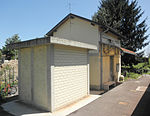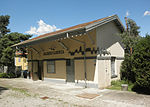The Monza Circuit (Italian: Autodromo Nazionale di Monza, lit. 'National Motor Racetrack of Monza') is a historic 5.793 km (3.600 mi) race track near the city of Monza, north of Milan, in Italy. Built in 1922, it was the world's third purpose-built motor racing circuit after Brooklands and Indianapolis and the oldest in mainland Europe. The circuit's biggest event is the Italian Grand Prix. With the exception of the 1980 running, the race has been hosted there since 1949.Built in the Royal Villa of Monza park in a woodland setting, the site has three tracks – the 5.793 km (3.600 mi) Grand Prix track, the 2.405 km (1.494 mi) Junior track, and a 4.250 km (2.641 mi) high speed oval track with steep bankings which was left unused for decades and had been decaying until it was restored in the 2010s. The major features of the main Grand Prix track include the Curva Grande, the Curva di Lesmo, the Variante Ascari and the Curva Alboreto (formerly Curva Parabolica). The high speed curve, Curva Grande, is located after the Variante del Rettifilo which is located at the end of the front straight or Rettifilo Tribune, and is usually taken flat out by Formula One cars.
In addition to Formula One, the circuit previously hosted the 1000 km Monza, an endurance sports car race held as part of the World Sportscar Championship and the Le Mans Series. Monza also featured the unique Race of Two Worlds events, which attempted to run Formula One and USAC National Championship cars against each other. The racetrack also previously held rounds of the Grand Prix motorcycle racing (Italian motorcycle Grand Prix), WTCC, TCR International Series, Superbike World Championship, Formula Renault 3.5 Series and Auto GP. Monza currently hosts rounds of the Blancpain GT Series Endurance Cup, International GT Open and Euroformula Open Championship, as well as various local championships such as the TCR Italian Series, Italian GT Championship, Porsche Carrera Cup Italia and Italian F4 Championship, as well as the Monza Rally Show. In 2020 Monza hosted the 2020 World Rally Championship final round, ACI Rally Monza, with the circuit hosting 10 of the 16 rally stages.
Monza also hosts cycling and running events, most notably the Monza 12h Cycling Marathon and Monza 21 Half Marathon. The venue was also selected by Nike scientists for the Breaking2 event, where three runners attempted to break the 2 hour barrier for the marathon. Eliud Kipchoge ran 2:00:25.A very fast circuit, Monza has been the site of many fatal accidents, especially in the early years of the Formula One world championship, and has claimed the lives of 52 drivers and 35 spectators. Track modifications have continuously occurred, to improve spectator safety and reduce curve speeds, but it is still criticised by the current drivers for its lack of run-off areas, most notoriously at the chicane that cuts the Variante della Roggia.








